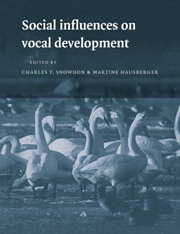Book contents
- Frontmatter
- Contents
- List of contributor
- 1 Introduction
- 2 Social interaction and sensitive phases for song learning: A critical review
- 3 Social interaction and vocal development in birds
- 4 Building a social agenda for the study of bird song
- 5 Field observations, experimental design, and the time and place of learning bird songs
- 6 Vocal learning in wild and domesticated zebra finches: Signature cues for kin recognition or epiphenomena?
- 7 What birds with complex social relationships can tell us about vocal learning: Vocal sharing in avian groups
- 8 Social influences on song acquisition and sharing in the European starling (Sturnus vulgaris)
- 9 Social influences on the acquisition of human-based codes in parrots and nonhuman primates
- 10 Vocal learning in captive bottlenose dolphins: A comparison with humans and nonhuman animals
- 11 Vocal learning in cetaceans
- 12 Social influences on vocal development in New World primates
- 13 Some general features of vocal development in nonhuman primates
- 14 Social influences on vocal learning in human and nonhuman primates
- 15 The resilience of language in humans
- 16 Reciprocal interactions and the development of communication and language between parents and children
- 17 Crafting activities: Building social organization through language in girls' and boys' groups
- Index
1 - Introduction
Published online by Cambridge University Press: 04 August 2010
- Frontmatter
- Contents
- List of contributor
- 1 Introduction
- 2 Social interaction and sensitive phases for song learning: A critical review
- 3 Social interaction and vocal development in birds
- 4 Building a social agenda for the study of bird song
- 5 Field observations, experimental design, and the time and place of learning bird songs
- 6 Vocal learning in wild and domesticated zebra finches: Signature cues for kin recognition or epiphenomena?
- 7 What birds with complex social relationships can tell us about vocal learning: Vocal sharing in avian groups
- 8 Social influences on song acquisition and sharing in the European starling (Sturnus vulgaris)
- 9 Social influences on the acquisition of human-based codes in parrots and nonhuman primates
- 10 Vocal learning in captive bottlenose dolphins: A comparison with humans and nonhuman animals
- 11 Vocal learning in cetaceans
- 12 Social influences on vocal development in New World primates
- 13 Some general features of vocal development in nonhuman primates
- 14 Social influences on vocal learning in human and nonhuman primates
- 15 The resilience of language in humans
- 16 Reciprocal interactions and the development of communication and language between parents and children
- 17 Crafting activities: Building social organization through language in girls' and boys' groups
- Index
Summary
In the late 1960s a series of developments in linguistics, developmental psycholinguistics and animal communication led to a convergent model of vocal development in human and nonhuman species. As presented by Lenneberg (1967) and Marler (1970), the development of language and of bird song required exposure to species-specific codes during a sensitive period of development, after which subsequent learning was extremely limited. The amount of input required could be quite small, and this input could be effective regardless of social interactions. Both birds and humans needed intact hearing and an extensive time for practice (babbling for human infants, subsong and plastic song for birds) to acquire adult competence in vocal production. Subsequent to this practice crystallization occurred, and further changes in vocal structure were rare.
This paradigm has led to extremely productive research over the past 25 years, not only in the study of vocal development but also in the understanding of the neurological controls of vocal production. However, as researchers interested in the ontogeny of primate and avian vocal communication, we have become increasingly aware of the need to consider some modifications to this paradigm. Some forms of social stimulation can extend sensitive periods for song learning in birds, and songs and calls in some species can be modified throughout life, often in response to changes in social stimuli. Parrots, dolphins and great apes with exceptional training acquired codes with some similarities to human language. Yet at the same time there was little evidence of vocal plasticity in nonhuman primates, suggesting a gap in continuity of developmental processes in the evolution from birds to humans.
- Type
- Chapter
- Information
- Social Influences on Vocal Development , pp. 1 - 6Publisher: Cambridge University PressPrint publication year: 1997
- 2
- Cited by



